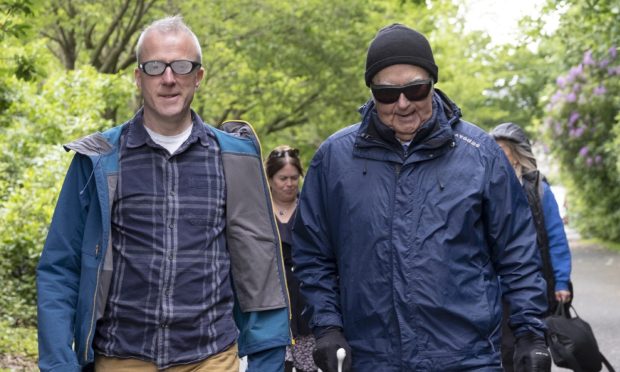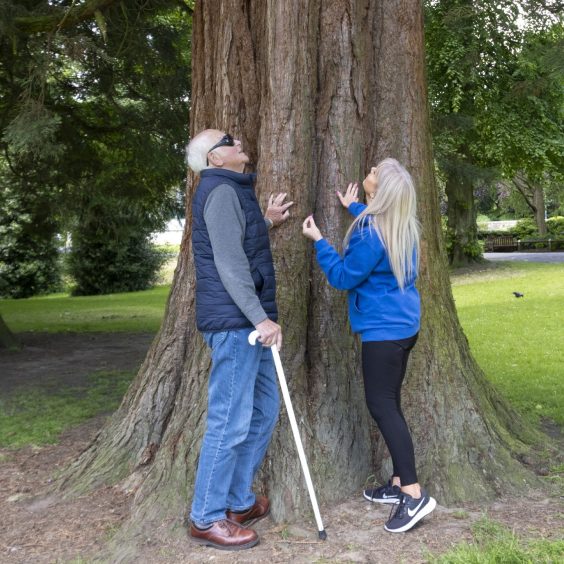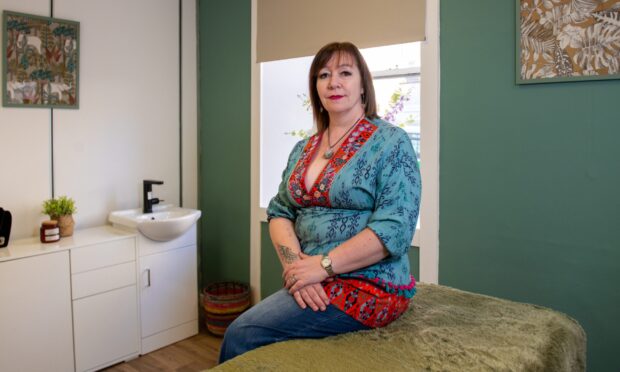Walking in nature improves physical health by enhancing cardiovascular fitness and reducing blood pressure.
It also boosts mental health by decreasing stress, enhancing mood and improving cognitive function.
But why is it particularly beneficial for people who are blind or visually impaired?
The Courier was invited to join Fife sight-loss charity Seescape on one of its sensory nature walks as it launches a fresh appeal for volunteers.
The sensory walks involve lots of stopping and touching, smelling and listening to birds – so while the participants can’t see the setting, they get huge benefits from being out and about, as well as physical exercise and friendship.
I meet up with the team at Pittencrieff Park in Dunfermline on an unseasonably cold Wednesday morning.
To simulate sight-loss, I’m asked to wear a pair of special glasses to replicate the symptoms of age-related macular degeneration.
That’s a degenerative condition affecting the central part of the retina (the macula) and resulting in distortion or loss of central vision.
How much could I see on my Fife nature walk for the blind?
Walking in the park with little more than a pin prick of tunnel vision, it quickly becomes apparent that without sight your other senses heighten.
Once I overcome the fear of tripping over things, I feel the warmth of the sun and the cool shade of trees on my skin.
The air carries a multitude of scents: the earthy smell of soil, the sweet fragrance of blooming flowers, the fresh scent of grass, and sometimes the faint aroma of distant food stands.
Sounds become my primary guide. I hear the rustle of leaves as the wind gently passes through the trees. Birds chirp and sing in a symphony, their calls echoing from various directions.
The distant laughter of children playing at a local playpark, the rhythmic jog of footsteps, and the casual conversations of passers-by create a vibrant auditory landscape.
There’s the opportunity to reach out to touch the rough bark of a tree or the delicate petals of a flower. Each texture tells a story: the smoothness of a bench, the cool metal of a railing, or the soft leaves of a bush.
Walking through a park without sight is an immersive journey where every step is guided by sounds, smells and textures, creating a vivid picture of the world around me.
It’s a reminder that there is more to the world than what can be seen; it’s about what can be felt, heard and touched.
Crucially, however, this is also an opportunity to speak with a regular participant of the nature walks and to find out more from the team about why the walks are so worthwhile.
What inspired Ian Todd to join Seescape’s Fife nature walks for the blind?
Speaking as we walk through the park together, 73-year-old Ian Todd explains how he started going on the fortnightly walks in February after being diagnosed with glaucoma – a common eye condition where the optic nerve, which connects the eye to the brain, becomes damaged.
Originally from Cowdenbeath, Ian, now of Crossgates, has had good eyesight for most of his life.
Leaving school to do an apprenticeship at Rosyth naval dockyard where he worked for 11 years, the grandfather of two raised a family with his wife Christine going on to work for 15 years with the old SSEB electricity board.
Ian, who already wore glasses for monovision, first knew something “wasn’t right” with his eyes in 2018/19.
After being told by his optician that everything was fine, he sought the opinion of a different optician with the hospital confirming in April 2022 that he had glaucoma.
Put on eye drops for a year, he underwent eye operations in April and October last year, followed by a cataract operation on his right eye about four weeks ago.
Today, wearing dark shades and carrying a stick to aid him, he can “see a lot of things that are directly in front but can’t always see something to the side”.
But what he enjoys most about the Seescape nature walks is it’s an opportunity to “walk and chat to people” – and crucially, gets him active and out of the house.
Ian, who still gets out every day to walk his two Scottish Terriers, and is on the committee of The Scottish Terrier Club (Scotland) Championship Show, also goes to a separate Social Eyes Fife walking group in Cowdenbeath every second Wednesday.
“When I was diagnosed with glaucoma at the hospital, the first guy who spoke to me asked ‘how did you get here?’ and I replied ‘I drove’,” he says.
“He said ‘you’ll need to get somebody to drive you back’. I had to give up my licence, my car – although luckily my wife drives.
“I’d also taken up photography when I retired. It means I now can’t get to the places I’d really like to get to. I still do a bit of photography. The camera club helps me get to places.
“But these walks are great. I’ve been doing them every fortnight since winter – although it’s four weeks since we were here last time because of the weather.
“I would say to anyone interested to get in touch!”
Co-ordinator Wendy Leary highlights physical and mental health benefits
Wendy Leary is health and wellbeing co-ordinator for Seescape.
Originally from Sheffield, Wendy, who’s been in Fife around 20 years, comes from a social care and fitness instructor background.
She was originally involved in support of the nature walks but, when another volunteer was unable to continue, she “didn’t want to let them down” and took on the co-ordinator role to keep it going.
“The walks are not just all about the sensory side of it, but the mental side of it, health and wellbeing too,“ she explains.
“You are talking about exercise – walking round for an hour, talking about what happened in their past. They are quite open to talk about anything. It’s good for them and they enjoy it so much. They’ll joke and they’ll laugh. It relaxes their day.”
Wendy helps assess those who want to take part. It’s like a general risk assessment of health. With another three participants due to join the Dunfermline group, they’ll become a weekly thing.
But that’s dependent on there being enough volunteers to make it viable. There are already some people on a waiting list.
“The feedback that we get is amazing,” she adds.
“The difference that it can make in someone’s life. You don’t know what the impact of losing their eyesight can have on a person. Depression can set in. Their self-confidence goes. Self-belief goes.
“The work I’m involved with is all about building the confidence up. They’ll want to go out more.”
Volunteers are essential to widening out the programme, says CEO Lesley Carcary
Lesley Carcary is the Glenrothes-based CEO of Seescape.
She explains that a lot of groups like this one in Dunfermline are entirely volunteer led.
There’s also ambition to open similar groups elsewhere in Fife – if enough volunteers can be found.
“We are extremely lucky to have this one that Wendy started off, but we’ve had loads of interest from Cupar, Kirkcaldy, Glenrothes to set up similar groups,” she says.
“But the problem is, because all our clients are sight impaired, you need a good ratio of people with sight and people with no sight so it’s safe.
“Volunteer guides on the walks will talk about what they are seeing, they’ll guide towards what to touch and smell, lots of different sensory experiences, so you need quite a lot of volunteers to make that a worthwhile experience.”
Lesley said they recently tried to set up a similar group in Kirkcaldy’s Beveridge Park.
For the few months it was running it was “really popular”. However, there weren’t enough volunteers to keep it going.
“We do find that with a lot of our clients, because a lot of our sight-loss is age related, a lot of our clients are elderly and we do find that mobility can be an issue,” she adds.
“Quite often if they are not doing enough it can be quite easy just to sit in your house and start to lose your mobility and fitness.
“If you have sight-loss it can be harder to get out and about. We do encourage them to keep active and something like this is the perfect opportunity for that.
“It also helps with social engagement as well.
“We tend to find that a of our clients – especially if they are living on their own – can become quite lonely and isolated, particularly the men.
“So it’s a really good opportunity for them to socialise with peers and I believe there has been some strong friendships made on some of these groups.”
To find out more about Seescape go to www.seescape.org.uk





















Conversation